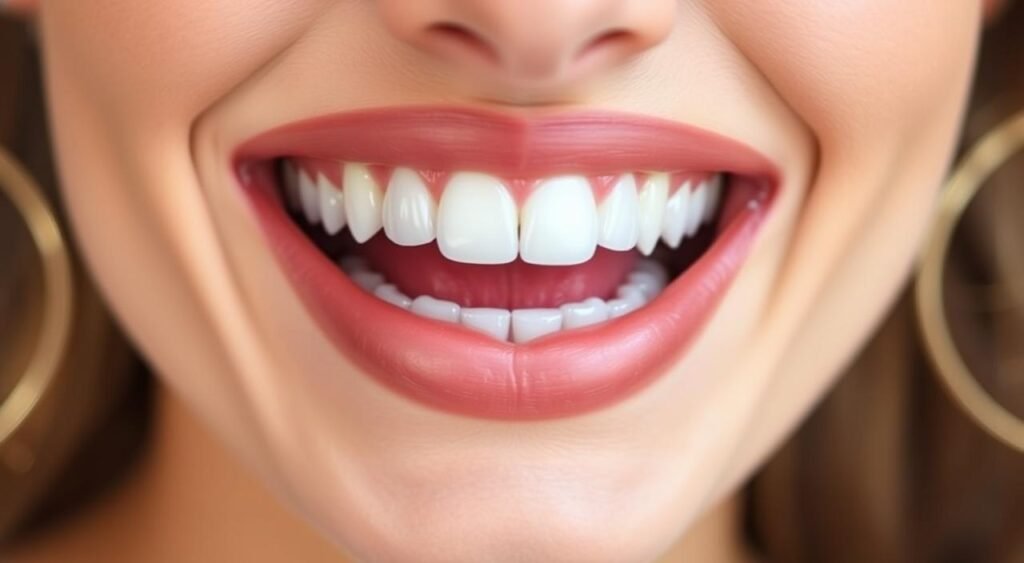Teeth whitening for porcelain veneers can be essential to maintaining the radiant smile you envisioned. Have you ever caught your reflection and noticed your smile seemed less bright? If you’ve invested in porcelain veneers, this can be disappointing, especially when veneers are designed to give you a lasting, brilliant smile.
Don’t worry, you’re not alone. Many people with dental veneers wonder about whitening options over time. The good news is, there are ways to get back that bright smile you loved when you first got your veneers.
In this guide, we’ll cover everything about whitening porcelain veneers. We’ll talk about why veneers might lose their shine and how to safely whiten them. We’ll explore cosmetic teeth whitening and how to keep your smile bright for years.
Porcelain Veneers and Their Stain-Resistant Properties
Dentistry porcelain veneers are a great way to get a beautiful smile. They are thin shells made to fit over your teeth. This makes them a lasting and attractive choice for a better smile.
What are porcelain veneers?
Porcelain veneers are thin, custom-made shells for your teeth. They look like your natural teeth but are made to last. They can fix many issues like discoloration, chips, and gaps.
The stain-resistant nature of porcelain
Porcelain veneers don’t stain easily. Unlike natural teeth, they keep their color. This is because porcelain doesn’t absorb stains, keeping your smile bright.
Longevity and durability of veneers
Porcelain veneers are very durable and last a long time. With the right care, they can last 10 to 15 years. This makes them a smart choice for a long-lasting smile. Taking care of your teeth and veneers can make them last even longer.
Causes of Discoloration in Porcelain Veneers
Porcelain veneers are known for their stain-resistant properties. Yet, over time, they can experience discoloration. Knowing the causes can help keep your smile bright for longer.
Wearing Down of Porcelain Glazing
The front surface of porcelain veneers has a protective glazing. This layer can wear down, making the veneer more prone to stains. Coffee, wine, and tea can then leave marks on your once-pristine veneers.
Gum Recession and Exposed Surfaces
Gum recession is a natural part of aging. It can expose the edges of your veneers where they meet your natural teeth. This area is more prone to staining and can affect your smile’s look.
Tooth Trauma and Internal Changes
Injury to a tooth with a veneer can cause internal discoloration. The thin nature of veneers means this darkening might show through, impacting your smile’s appearance. In such cases, tooth whitening treatments for the underlying tooth may be necessary.
Other factors that can lead to discoloration include:
- Aging of the dental cement used to bond veneers
- Micro-abrasions on the veneer surface trapping stains
- Older composite veneers being more porous than porcelain
Regular dental check-ups and proper care can help prevent many of these issues. If you notice changes in your veneers’ color, consult your dentist for professional advice and cleaning options.
Teeth Whitening for Porcelain Veneers: Options and Limitations
Whitening porcelain veneers is not the same as whitening natural teeth. Traditional whitening methods don’t work because veneers are not porous. It’s key to know what you can and can’t do to whiten them.
Getting a professional cleaning from a dentist is the best way to brighten veneers. This can remove stains and make them shine again. Sometimes, dentists might suggest whitening the teeth behind translucent veneers for a better look.
Don’t try at-home whitening kits on your veneers. They can harm the surface. Always talk to a dentist before trying to whiten your veneers.
- Professional cleaning is best for veneer whitening
- Avoid using at-home whitening kits on veneers
- Consult a dentist before any whitening attempt
If your veneers are very discolored, you might need to replace them. Veneers can last 10-15 years with good care. If your veneers are almost worn out, your dentist might suggest getting new ones for a brighter smile.
Preventing stains is important. Avoid foods and drinks that stain, don’t use tobacco, and use gentle toothpaste. Regular dental visits can help keep your veneers looking great and catch any problems early.
Professional Cleaning and Polishing Techniques
Professional cleanings are key to keeping your porcelain veneers looking great. Regular dentist visits can make your veneers shine for many years.
Benefits of Professional Dental Cleaning
Professional veneer whitening has many benefits:
- Removes plaque and bacteria buildup
- Restores shine to your veneers
- Improves overall oral health
- Detects early signs of gum disease or decay
Polishing Methods to Restore Shine
Dentists use special techniques to brighten veneers:
- Non-abrasive polishing compounds
- Gentle buffing to remove surface stains
- Refinishing the porcelain glaze
These methods are safe and effective for stain removal for veneers without damaging the delicate porcelain surface.
Frequency of Professional Maintenance
The frequency of professional cleanings varies based on your needs. Most dentists suggest visits every six months for veneer care and oral health. Regular check-ups help your dentist keep an eye on your veneers and fix any issues quickly.
Remember, professional cleanings are just part of veneer care. Brush twice a day with a soft-bristled toothbrush. Avoid staining foods and drinks, and don’t use abrasive toothpaste. This keeps your veneers looking their best between dentist visits.

At-Home Care for Maintaining White Veneers
To keep your porcelain veneers looking great, you need to take good care of them. Brush your teeth twice a day with a soft toothbrush and gentle toothpaste. This way, you clean your teeth well without harming your veneers.
Don’t forget to floss every day. It helps get rid of plaque and food bits between your teeth. This keeps your mouth healthy and your veneers looking good. Also, be careful with what you eat and drink, as some things can stain your veneers.
- Limit coffee, tea, and red wine consumption
- Avoid tobacco products
- Rinse your mouth after eating or drinking staining substances
Use a mouthwash that doesn’t have alcohol to prevent plaque and gum disease. If you play sports, wear a mouthguard to protect your veneers. Remember, veneers can’t be whitened like natural teeth. So, keeping them the same color is key for a lasting, bright smile.
When to Consider Veneer Replacement
Dental veneers can change your smile, but they won’t last forever. It’s important to know when to replace them to keep your smile bright and healthy. Most veneers last 10-15 years, but with care, they can last up to 20 years.
Signs of Aging Veneers
Look out for these signs that your veneers need to be replaced:
- Visible staining resistant to veneers teeth whitening
- Chipping or cracking
- Dull appearance despite professional cleaning
- Separation from the gum line
- Decay in supporting teeth
The Replacement Process
Replacing veneers is similar to getting them the first time. Your dentist will remove the old ones, take new molds, and bond new veneers. This usually takes three visits over six weeks. It’s best to choose a trusted cosmetic dentist for the best results.
Improving Veneer Longevity
Here are some tips to make your veneers last longer:
- Avoid using teeth as tools
- Stay away from tobacco products
- Limit staining foods and drinks
- Schedule regular dental cleanings every six months
- Floss daily and use soft-bristle toothbrushes
- Wear a mouthguard for sports or teeth grinding
By following these tips and keeping up with good oral hygiene, you can keep your veneers looking great for years.
Conclusion
Porcelain veneers are a top choice for a stunning smile. They resist stains well, thanks to their high-quality ceramic. But, whitening them isn’t as easy as natural teeth. With the right care, you can keep your smile bright.
Keep your veneers clean with regular brushing and flossing. Also, don’t forget dental checkups. Use soft toothpaste to avoid scratches. Some foods and drinks can stain them, but a professional cleaning can fix that.
Your veneers can last a decade or more with the right care. For those on a budget, places like Los Algodones, Mexico, offer quality veneers at lower prices. This way, you can get a smile makeover without breaking the bank.
Prevention is key to a long-lasting smile. Good oral hygiene and professional care will keep your veneers in great shape. They’re an investment in your confidence. Take care of them, and they’ll keep you smiling for years.
FAQ – Porcelain Veneers Care
Can traditional teeth whitening methods whiten porcelain veneers?
No, traditional whitening methods don’t work on porcelain veneers. This is because veneers don’t soak up whitening agents like natural teeth do.
How can I safely whiten my porcelain veneers?
The best way to whiten veneers is through professional cleaning by a dentist. They use special tools to remove stains and make your veneers shine again.
What causes discoloration in porcelain veneers?
Several things can cause veneers to lose their shine. These include wear and tear of the glazing, gum recession, tooth trauma, and the cement used to bond the veneer can also stain over time.
How often should I get professional cleaning for my veneers?
How often you need a professional cleaning depends on your situation. But, regular dental visits are key to keeping an eye on your veneers. Your dentist will tell you how often you should come in.
What at-home care tips can help maintain white veneers?
To keep your veneers looking good, use a soft-bristle brush and gentle toothpaste. Stay away from harsh whitening toothpastes. Brush after eating or drinking things that can stain. Limit foods like coffee and red wine. Floss often and use toothpaste your dentist says is safe for veneers.
When should I consider replacing my porcelain veneers?
You might need new veneers if they’re very stained or show signs of wear like chipping. Even if they look dull, cleaning them won’t fix it. Usually, veneers last 10-15 years, but good care can make them last longer.








